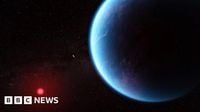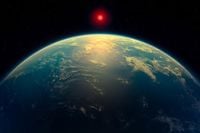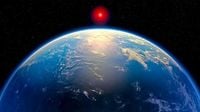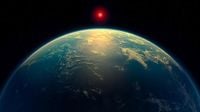In a groundbreaking development in the search for extraterrestrial life, scientists have discovered promising hints of biological activity on a distant planet known as K2-18b. This exoplanet, located approximately 124 light-years away from Earth, has shown signs of sulfur-bearing gases in its atmosphere, specifically dimethyl sulfide (DMS) and dimethyl disulfide (DMDS), which are typically associated with life on Earth. The findings were made using the James Webb Space Telescope (JWST) and have sparked excitement among astronomers and astrobiologists alike.
The research team from Cambridge University, led by Professor Nikku Madhusudhan, detected these molecules during a recent observation of K2-18b as it transited its parent star. The detection of DMS and DMDS is significant because, on Earth, these gases are produced primarily by marine phytoplankton and other simple organisms. This marks the second time that chemicals associated with life have been identified in the atmosphere of K2-18b, following earlier observations that hinted at the presence of similar compounds.
"This is a transformational moment in the search for life beyond the solar system," Madhusudhan stated. "We have demonstrated that it is possible to detect biosignatures in potentially habitable planets with current facilities. We have entered the era of observational astrobiology." The team's findings were published in The Astrophysical Journal Letters on April 16, 2025.
K2-18b is classified as a Hycean world, a term coined by Madhusudhan to describe planets that are covered by vast oceans and have hydrogen-rich atmospheres. The planet is approximately 2.6 times the diameter of Earth and weighs about 8.6 times as much. It orbits within the habitable zone of a cool red dwarf star, K2-18, which allows for the possibility of liquid water existing on its surface.
The recent observations revealed that the concentration of DMS in K2-18b's atmosphere is more than ten parts per million, thousands of times higher than levels found on Earth, where it rarely exceeds one part per billion. This striking difference suggests that if the association with life is genuine, K2-18b could be teeming with microbial life.
However, the researchers caution that the detection is not yet definitive. The current confidence level of the findings stands at 99.7%, categorized as a three-sigma result. To claim a discovery, scientists typically require a five-sigma result, which implies a probability of less than 0.00006% that the observation is a statistical fluke. Madhusudhan expressed optimism that further observations could push the results over the threshold needed for a more definitive conclusion.
"This is the strongest evidence yet there is possibly life out there," Madhusudhan added. "I can realistically say that we can confirm this signal within one to two years." He emphasized the importance of continued scrutiny and verification, stating, "It’s important that we’re deeply skeptical of our own results, because it’s only by testing and testing again that we’ll reach the point where we’re confident in them. That’s how science has to work."
Independent scientists have echoed the need for caution. Professor Catherine Heymans, Scotland's Astronomer Royal, noted that even with a five-sigma result, questions would remain regarding the origin of the detected gases. "Even with perfect data we can't say for sure that this is of a biological origin on an alien world because loads of strange things happen in the Universe," she explained.
Other researchers have proposed alternative explanations for the presence of DMS and DMDS. Some suggest that geological processes or exotic photochemistry could generate these gases without biological involvement. For instance, Dr. Nicolas Wogan from NASA's Ames Research Center has theorized that K2-18b could be a mini gas giant with no solid surface. Such debates highlight the ongoing scientific discourse surrounding the interpretation of data from K2-18b.
The Cambridge team is actively collaborating with other research groups to explore whether DMS and DMDS can be produced by non-living means in laboratory settings. This approach aims to strengthen the understanding of the atmospheric composition of K2-18b and the potential for life on other planets.
The search for life beyond Earth has intensified in recent years, with scientists investigating various celestial bodies within our solar system and beyond. K2-18b, however, stands out due to its unique characteristics and the compelling evidence gathered thus far. As the JWST continues to gather data, the scientific community eagerly anticipates further insights into the possibility of life on this distant world.
"Decades from now, we may look back at this point in time and recognize it was when the living universe came within reach," Madhusudhan remarked. This sentiment encapsulates the excitement and hope that the latest findings on K2-18b inspire within the scientific community. The planet's exploration could ultimately reshape our understanding of life in the universe and our place within it.
In summary, the detection of dimethyl sulfide and dimethyl disulfide in the atmosphere of K2-18b represents a significant step forward in the quest to find extraterrestrial life. While more research is needed to confirm these findings and rule out alternative explanations, the implications of this discovery are profound. As scientists continue to analyze the data and conduct further observations, K2-18b may well emerge as a leading candidate in the search for life beyond our planet.







